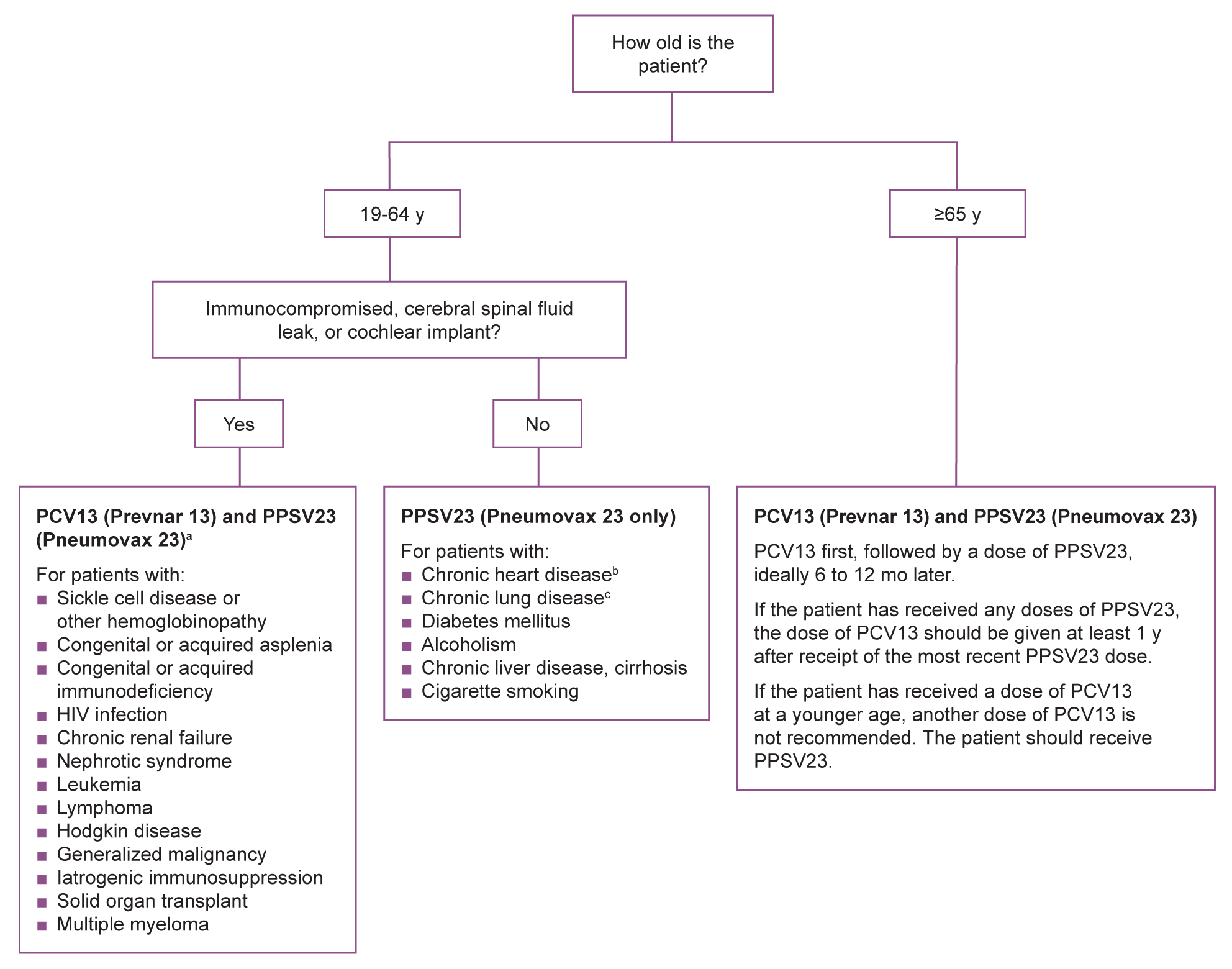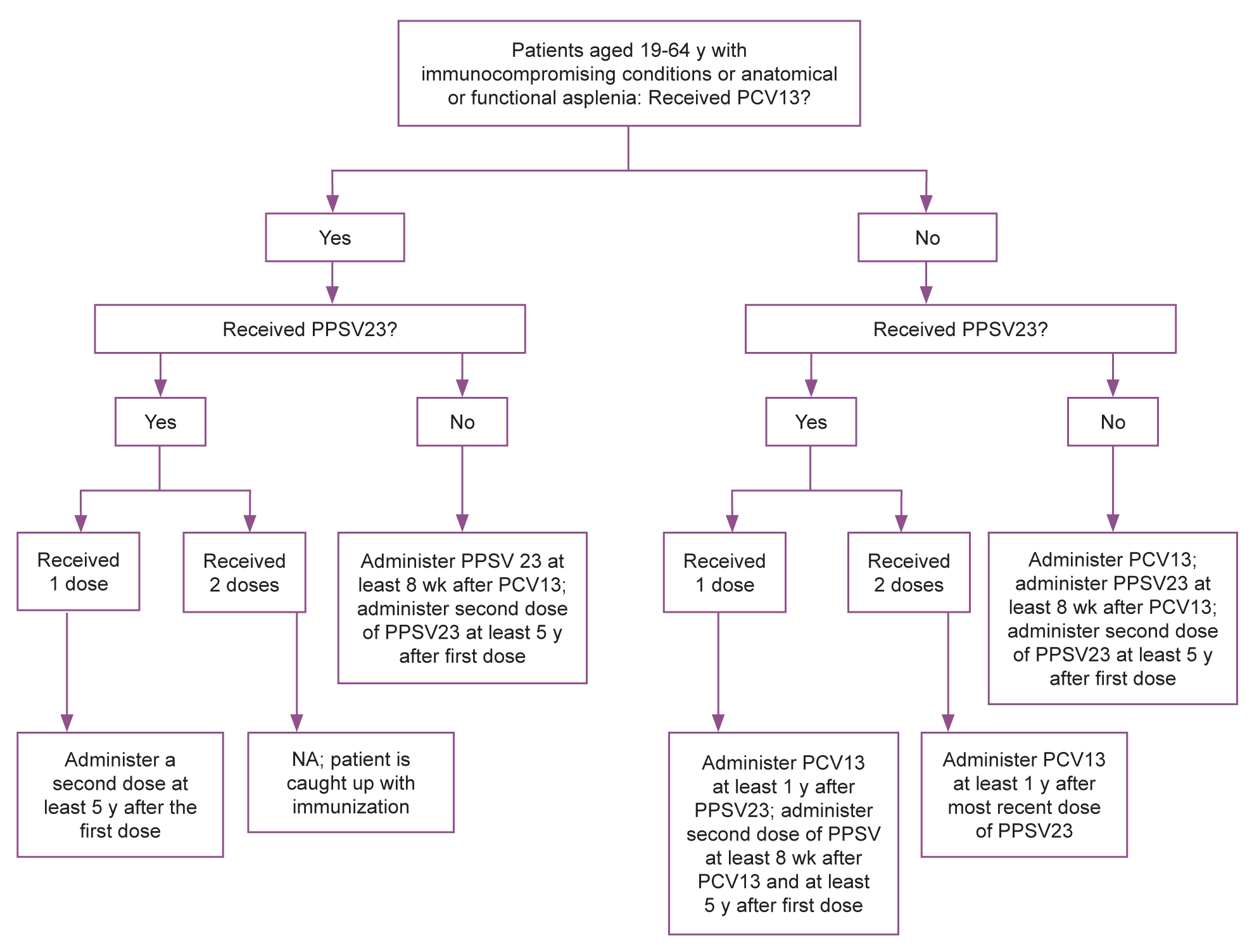Fast Facts I For Your Patients I Pneumoococcal I Continuing Education
Fast Facts
- Pneumococcal disease is any type of infection caused by streptococcus pneumoniae bacteria.
- There are 2 types of vaccine available in the US: conjugate and polysaccharide vaccines.
- Conjugate vaccine recommended for: all babies, children < 2 years, adults 65+, people 2-64 with certain medical conditions.
- Polysaccharide vaccine recommended for adults 65+, people 2-64 at an increased risk due to certain medical conditions, and adults 19-64 who smoke cigarettes
Pneumococcal Vaccination Recommendations
The following guidelines and flowchart are from:
Pneumococcal Guidelines

Pneumococcal Flowchart

National Immunization Survey Data:
Percent of Children 19-35 Months Who Have Received ≥ 3 PCV
(2020 Goal: 90.0%)
| Year | Nationally | Delaware |
|---|---|---|
| 2008 | 80.1 | 79.8 |
| 2009 | 80.4 | 81.6 |
| 2010 | 83.3 | 87.9 |
| 2011 | 84.4 | 84.5 |
| 2012 | 81.9 | 87.0 |
| 2013 | 82.0 | 88.0 |
| 2014 | 82.9 | 85.9 |
| 2015 | 84.1 | 90.8 |
The CDC changed the way that NIS results are reported starting in 2019. In the past, results were reported for children 19-35 months of age at the time of the survey. Now, results for most vaccines are reported at 24 months of age by birth year. Exemptions to this are the hepatitis B birth dose and Rotavirus vaccines which are reported at younger ages because they are completed before 24 months.
Percent of Children at 24 Months Who Have Received ≥ 3 PCV
| Birth Year | Nationally | Delaware |
|---|---|---|
| 2015-2016 | 91.9 | 94.3 |
| 2016-2017 | 92 | 93.9 |
| 2017-2018 | 92.4 | 95.4 |
top
For Your Patients
Fact Sheet: English | Spanish
Conjugate (PCV13) Vaccine Information Statement: English | Spanish
Polysaccharide (PPSV23) Vaccine Information Statement: English | Spanish
Infographic: here
top
Pneumococcal Disease
From the CDC’s Pink Book:
Streptococcus pneumoniae bacteria are lancet-shaped, gram-positive, facultative anaerobic organisms. They are typically observed in pairs (diplococci) but may also occur singularly or in short chains. Some pneumococci are encapsulated, their surfaces composed of complex polysaccharides. Encapsulated organisms are pathogenic for humans and experimental animals, whereas organisms without capsular polysaccharides are not. Most S. pneumoniae serotypes have been shown to cause serious disease, but only a few serotypes produce the majority of pneumococcal infections. The 10 most common serotypes are estimated to account for about 62% of invasive disease worldwide. The ranking and serotype prevalence differ by patient age group and geographic area. In the United States, the seven most common serotypes isolated from blood or cerebrospinal fluid (CSF) of children younger than 6 years of age account for 80% of infections. These seven serotypes account for only about 50% of isolates from older children and adults.
The major clinical syndromes of pneumococcal disease are pneumonia, bacteremia, and meningitis. Pneumococcal pneumonia is the most common clinical presentation of pneumococcal disease among adults. The incubation period of pneumococcal pneumonia is short, about 1 to 3 days. Symptoms generally include an abrupt onset of fever and chills or rigors. Classically there is a single rigor, and repeated shaking chills are uncommon. Other common symptoms include pleuritic chest pain, cough productive of mucopurulent, rusty sputum, dyspnea (shortness of breath), tachypnea (rapid breathing), hypoxia (poor oxygenation), tachycardia (rapid heart rate), malaise, and weakness. Nausea, vomiting, and headaches occur less frequently.
Approximately 400,000 hospitalizations from pneumococcal pneumonia are estimated to occur annually in the United States. Pneumococci account for up to 36% of adult community-acquired pneumonia.
Pneumococci cause over 50% of all cases of bacterial meningitis in the United States. An estimated 3,000 to 6,000 cases of pneumococcal meningitis occur each year. Symptoms may include headache, lethargy, vomiting, irritability, fever, nuchal rigidity, cranial nerve signs, seizures and coma. The case-fatality rate of pneumococcal meningitis is about 8% among children and 22% among adults. Neurologic sequelae are common among survivors.
Adults with certain medical conditions are at highest risk for invasive pneumococcal disease : immunocompromising conditions, either from disease or drugs, functional or anatomic asplenia, and renal disease. Other conditions that increase the risk of invasive pneumococcal disease include chronic heart disease, pulmonary disease (including asthma in adults), liver disease, smoking cigarettes (in adults) CSF leak, and having a cochlear implant.
S. pneumoniae has become the leading cause of bacterial meningitis among children younger than 5 years of age in the United States. Before routine use of pneumococcal conjugate vaccine, children younger than 1 year had the highest rates of pneumococcal meningitis, approximately 10 cases per 100,000 population.
top
Continuing Education
You Call The Shots: Pneumococcal (expires 6/22/2024)
top